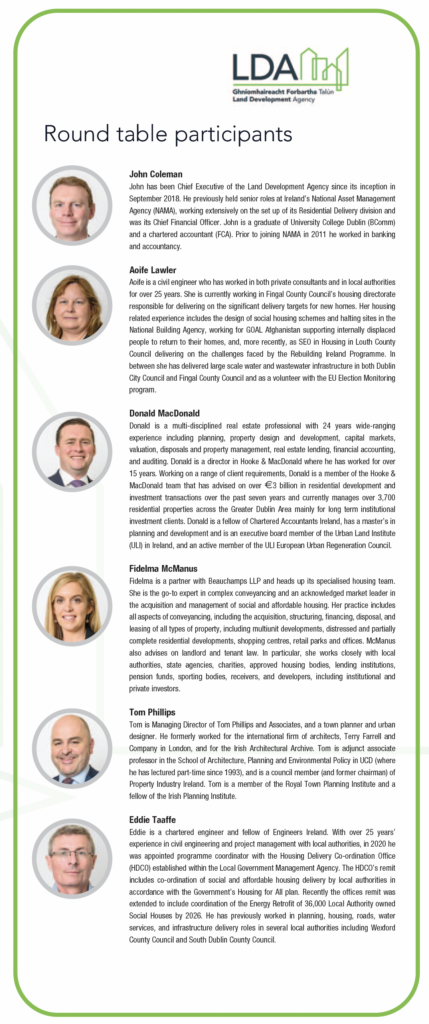
Focusing on construction to deliver social and cost rental homes
18th July 2023
107 actions ‘to facilitate disabled people to live independently’
18th July 2023Unlocking state land and opening doors to affordable homes

Following the publication of the inaugural Report on Relevant Public Land 2023, The Land Development Agency (LDA) hosted a round table discussion with key stakeholders from across the public and private sectors to discuss the delivery of affordable homes on state lands.
with key stakeholders from across the public and private sectors to discuss the delivery of affordable homes on state lands.
What are the most significant challenges associated with affordable housing delivery on state lands?
John Coleman
Firstly, one of the biggest challenges is getting access to the land in the first place. There tends to be a reason the land is unavailable; you may have a land-owning public service provider that uses it for a carpark or provides services that are not easy to move. Secondly, there is a disconnect between discourse and reality regarding the time required to get a housing project from greenfield to planning and from procurement to construction. There is a huge gap in the expectations of the public and politicians versus those delivering housing on the ground. There needs to be enhanced awareness of the realities of delivering housing.
Aoife Lawler
Many of the lands that are easy to develop are already developed and those remaining now have challenges in terms of infrastructure and services. If we can overcome those, we can deliver homes. The other factor is that we are not just delivering homes; we are delivering neighbourhoods, communities, and safe places for people to live. It is not just a case of building a house.
Donald MacDonald
John’s point around development timeframes is pertinent. It is understandable that people who do not work in the housing sector ask why something is or is not happening. Those close to development know that it takes years. Projects that we worked on last year included a site acquirement in 2007. From a planning perspective alone, development takes a long time and people need patience. The LDA and other organisations must be given time to see their strategies come to fruition. The other problem is houses versus apartments; apartments are much more complex to deliver and take even longer. There are also infrastructural issues that need to be solved, requiring all stakeholders working together. That is often unappreciated.
Fidelma McManus
By the time Beauchamps gets the instruction to buy a site, roughly two years’ work has been completed. Even with planning granted and a clear exit strategy, it takes two years to develop. Many people do not appreciate this reality. Therefore, they believe that the LDA and other public bodies can build with relative ease and speed. While there are many positive stories of different models delivering in different ways, the negatives resonate more because it takes so long to deliver. For example, a new cost rental tenure has been introduced with much collaboration. However, these homes are only beginning to be built. Things do not happen overnight. Likewise, Croí Cónaithe is still bedding in, and we have yet to see delivery. Expectations must be managed accordingly.
Tom Phillips
The three challenges are planning, infrastructure, and viability. There is a lack of understanding around how long developments take once granted planning permission. Planning is always in flux and always changing. We currently have new planning legislation forthcoming that will change things again. Overall, the delivery of infrastructure should be analogous to Wayne Gretzky’s comment on skating to where the puck will be. In Ireland, however, infrastructure trails development. With the exception of the Cherrywood extension of the Luas, there has been limited infrastructure delivery ahead of housing development. Water, buses, and schools cannot be delivered under departmental or agency rules and then An Bord Pleanála cannot give permission to developments where the infrastructure is not in place. We must change our attitude towards infrastructure and put it in place for development to happen. With regard to viability, we need foreign investment, and must not be naïve enough to think we can do it alone.
Eddie Taaffe
Redevelopment of state lands is not a single project; there is the also relocation of the services that are currently on the land. That is a distinct project even before approaching the risks associated with the redevelopment in planning and construction. If we consider the prime state land sites that should be redeveloped in our urban centres, they were originally built on the periphery and now we have developed around them. Trying to retrofit new developments into such areas is problematic. The reality must be faced that the occupiers of those sites are happy where they are, and the challenge is to get them to move. There is also the challenge around costs and when those are incorporated into delivery there is viability challenge. Having said that, across the State there is a recognition that the greater long-term cost is in not delivering now.
“There is an argument that policymakers are delivering policy for a generation that does not necessarily want home ownership. Obviously, people should be able to own their own homes if they are able to do so, but that should not be the primary objective.” Fidelma McManus
Timeframes for the development of land are lengthy. How can these be reduced?
Fidelma McManus
Overall, the timeframes can be reduced by ensuring that all parties involved understand what is required from the outset. Each party must understand what the other’s exit is and the milestones, challenges, and timelines for getting to those exits. Looking holistically at each development, from infrastructure to planning and delivery, each party must also be flexible. For instance, developers must have contingency plans and be aware of funding options in advance of encountering obstacles.
Eddie Taaffe
If we narrow it down to redevelopment of existing state landholdings, the single most important document to initiate a project is a letter of consent for planning. Several years are required then to finish designs and enter planning process proper. The letter of consent begins the process and buys time to establish the other requirements. Often in this country, however, we are guilty of approaching projects sequentially. Instead, as far as it is feasible, we must undertake them in parallel. The more time spent figuring out a project’s critical path, the more efficient its delivery.
Tom Phillips
During the Celtic Tiger and subsequent recession, many people opted for alternative study pathways rather than construction-related disciplines. Today, there is a 10-year lag in the associated skills capacity across both the public and private sectors. In particular, this has been a challenge for An Bord Pleanála; there is only person on their board who was on it a year ago, out of 15. Constant changes in personnel delays projects as per the Central Mental Hospital where there was a gap of several months between the issuing of the inspector’s report and An Bord’s ultimate decision. A properly resourced planning system must be in place for timely decisions. A more obligation-based approach would be better than an objectives-based one.
Donald MacDonald
Planning is a major challenge as anyone who works in the housing sector knows. Perhaps the forthcoming planning legislation will move things on but currently, planning in this country is far too complex. The amount of paperwork required for projects within existing standards is impeding progress. While we need a rigorous planning system, we are getting lost in the detail and are unable to deliver housing as a result.
“There is a huge gap in the expectations of the public and politicians versus those delivering housing on the ground. There needs to be enhanced awareness of the realities of delivering housing.” John Coleman
Aoife Lawler
I agree with the comments about the challenges relating to resources and expertise. Consequently, we are competing for the same cohort of talent, and though there are observable improvements, it remains a challenge. However, local authorities are good at forward planning, land banking, and delivering infrastructure for the future. As a sector, we are now planning for 2028 and 2030 rather than 2023 or 2024 because those are already at hand.
John Coleman
When considering the length of time required to take a site to completion, we sometimes focus on the build period and how we can shorten it, but that does not substantively move the dial in the larger scheme. Even with planning reforms, reductions in timeframe will be a matter of months. When must consider timespan holistically. For instance, the largest social and affordable scheme in the State at Shanganagh has been talked about for years and is only now being developed now. The overall timeframe beyond the build and planning periods must shorten, and, in that respect, Eddie’s point about approaching projects sequentially resonates with me.
Eddie Taaffe
As former director of planning in South Dublin County Council I find the narrative that planning is the problem tiresome. Everybody agrees that we need a robust planning system, so we cannot say that it is the problem. 93 per cent of applications in this country are successful. There are two things that must be clarified. Firstly, we must determine what constitutes a cast-iron environmental assessment, and secondly, we must introduce certainty into the timeframe. If a planning application is made, local authorities are statutorily bound to make decision within a specific timeframe. However, beyond that system, there is no certainty. These are the specific elements of the planning system which do not work.
“The public sector must incentivise the private sector to participate in the development of affordable homes. A major pillar of this approach is the recognition that public plans such as Housing for All must be flexible.” Donald MacDonald
How can the operational needs of existing public service landowners be balanced with the potential for the land to be used for affordable housing?
John Coleman
There must be greater long-term policy consideration. Consider the archetypal discourse around Dublin Port and why the LDA does not build housing there; the response from Dublin Port Company, justifiably, is that Dublin needs a port, and it makes sense to have it located where it is. Unless we are prepared to spend billions to move a port, that is the end of the discussion. However, with long-term thinking, it would be possible to consider what Ireland’s maritime policy is within broader transport policy. In that scenario, it may be possible to plan for a project as significant rather than ignoring it because it is not going to happen in the immediate term.
Fidelma McManus
Long-term planning is atypical in the public discourse; it is not widely understood that people like Aoife are already working ahead to 2030. The projects being undertaken by the LDA are not only important for the delivery of housing now but also for the establishment of communities and societal wellbeing decades from now. From my perspective, an easy win would be to utilise available public land to deliver housing near public services such as hospitals and schools. Simultaneously, having observed using the example of mixed tenure schemes in the UK, it is possible to deliver affordable housing schemes that are developed specifically for key workers, alongside schemes for elderly renters, and households that are downsizing.
Eddie Taaffe
On the point of long-term planning; one of the major hospitals in Dublin demolished its accommodation block to build a car park. That is a stark reminder of the lack of long-term strategic vision for housing and indeed for sustainable transport.
To what extent has the LDA’s first Report on Relevant Public Land contributed to the national debate on public land use?
Eddie Taaffe
At local authority level, the development plan process succeeded in determining the correct use of public land and state-owned land. Now, however, the LDA’s report has elevated the debate to a more strategic and national level.
Donald MacDonald
It is an amazing report. In our business, we regularly condense a significant amount of information about a particular property into a user-friendly format. When I read the Report on Relevant Public Land, it is apparent that the LDA team has been undertaking a similar task on much larger scale and to the extent that a newcomer to Irish housing could read it and gain a comprehensive understanding. There is so much value in the report and it will be up the various actors across the State to utilise it.
Aoife Lawler
There are many facets to this discussion, however, there is a preoccupation with home ownership rather than providing liveable and sustainable lifestyles and communities. The conversation must reorientate towards everyone having a home rather than everyone owning a home. Having a home includes renting adequate accommodation at an appropriate price. It is only after everyone has somewhere to live that we can then move on to private ownership. A component of this is working and living on the same site. There is no reason why some state agencies could not continue to base their operations on an existing site while also accommodating housing.
“The conversation must reorientate towards everyone having a home rather than everyone owning a home… It is only after everyone has somewhere to live that we can then move on to private ownership.” Aoife Lawler
Fidelma McManus
There is an argument that policymakers are delivering policy for a generation that does not necessarily want home ownership. Obviously, people should be able to own their own homes if they are able to do so, but that should not be the primary objective. Previously, we observed affordable housing schemes that did not work in this country because of the preoccupation with home ownership. Constitutionally, people want the right to own property, but like Aoife said, we must ensure that people have access to adequate housing first. Introducing a new housing tenure, such as cost rental, in a state is a massive achievement that has not received the acknowledgement that it deserves. Does it need to be tweaked? Of course, but it has introduced a viable alternative dimension to housing. People should be able to rent at a reasonable price and it would be a massive achievement if we could get this right – delivering cost rental at scale – for the eligible cohort, which includes but is not limited to key workers.
Tom Phillips
It is a very useful report. Two things stand out. Firstly, the overall quantum is not going to solve Ireland’s housing crisis. The LDA can deliver 66,910 new affordable homes but the Housing Commission has determined that we must deliver up to 62,000 homes each year until 2050 to meet demand. Secondly, there are constraints. There is no instantaneous solution to the housing crisis. It takes time. Simultaneously, we must not assume that the State will deliver the solution in isolation. Overall, the report has demonstrated that the solution necessitates public and private partnership. The LDA is part of the solution rather than the whole solution, but it needs support, and it needs state agencies to understand that they must cooperate to deliver the solution.
“A properly resourced planning system must be in place for timely decisions. A more obligation-based approach would be better than an objectives-based one.” Tom Phillips
John Coleman
My overarching interpretation of the report is that it was very worthwhile because the housing discourse tends to be binary; it is everything or it is nothing. Like everything in life, the reality is that it is more nuanced. This also applies to the discussion around state land. Some narratives have suggested that the State has abundant land that can be immediately developed to solve the housing crisis. That was never the case. The Report on Relevant Public Land has injected a dose of reality into the discourse, outlining what is in the state land bank, the associated challenges, the operations that are underway already, and the difficult choices that must be made. After its publication, I participated in a radio interview during which the interviewer asked if I was disappointed in the report’s findings. My response was that it is a statement of fact. State land will contribute to the solution, but it is not a panacea, and understanding this is a healthy approach. In addition, it has increased the level of transparency around state lands and enhanced the public debate.
How can collaboration across the public and private sectors accelerate the delivery of affordable homes on state land?
Donald MacDonald
The State, state bodies and AHBs can undoubtedly leverage the experience of the home development industry. For example, apartments are notoriously difficult units to build and rather than the public sector attempting to do it alone, there is scope for them to use their expertise in procurement and deliver avenues of funding for developers to then come in on the master plan. The public sector must incentivise the private sector to participate in the development of affordable homes. A major pillar of this approach is the recognition that public plans such as Housing for All must be flexible. The solution today may not be the solution in five years’ time and if we can ensure that plans are agile, then there is an opportunity to attract capital that does not come directly from government.
Tom Phillips
In my involvement as an advisor to the Housing Commission, I have been deeply impressed by its ability to bring together people from disparate backgrounds to work together towards solutions and collaborate openly. It is worth noting that some of these people may be at loggerheads in their day jobs but are willing to openly collaborate because of a recognition that the housing crisis can only be solved by collaboration between the public and private sector.
John Coleman
Collaboration between the public and private sector was reduced post the 2008 financial crash as it became difficult for the two sectors to work together. Thankfully, that has reversed somewhat and things like the Housing Commission have helped to knock down barriers. The private sector are very important delivery partners. The assumption that the State could deliver alone is a dangerous one because you would create linear delivery tied to the economic situation in the country and be doomed to continue the boom/bust cycle. The viability measures being considered for cost rental give cause for optimism, with a serious effort to assess attractiveness to the private sector.
Aoife Lawler
I recently visited an ex-military barracks in Paris which had been repurposed for the development of mixed-tenure housing which serves as an example of what we can achieve. Collaboration is already well underway. Fingal County Council has three schemes on site and more coming forward which are joint ventures with private developers to deliver homes.
“Often in this country, we are guilty of approaching projects sequentially. Instead, as far as it is feasible, we must undertake them in parallel.” Eddie Taaffe
Eddie Taaffe
In relation to delivery on State land, we have to move away from traditional employer design publicly procured projects. Currently, only a very small segment of the housing construction industry actually engages in the public procurement process and so we need to broaden that. To do so, we need to simplify the process utilising joint ventures and earlier involvement of the private sector. One of the barriers we need to overcome is a mindset of the public sector that they still know what is best when it comes to designing homes and capturing public demand. We need private sector involvement before the master plan stage and to shape their input into a public procurement process. Importantly, private sector engagement will require certainty of pipeline. If the private sector can see a series of projects, then they will be much more inclined to engage.
Fidelma McManus
Capacity is an issue in both the public and private sectors. Yes, the public sector doing its own development of affordable housing would be ideal, and it is something we can work towards, however, currently, the capacity to develop housing rests solely in the private sector. Where a private developer is being engaged to deliver a project, they still need the assurance of a project pipeline if they are to ensure capacity. That ties into the delivery of funding models. My overarching view of the different models for housing delivery is that while new models are welcome, we should not be removing current models from the menu until we have proven improved replacements, otherwise, we are potentially reducing the number of homes being delivered and opportunities for foreign investment, which help underpin the bigger picture of increased housing delivery.












